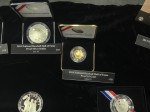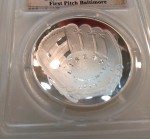With news coverage that covered almost every media outlet because of its unique curved design, the U.S. Mint invited Baltimore Orioles Hall of Famer Brooks Robinson to their booth at the Baltimore Convention Center on Thursday, March 27. Nothing gets the attention of the local Baltimore market more than bringing in a popular former Orioles player. Only Cal Ripkin, Jr. would have given them more attention and probably an even bigger draw.
By early Friday afternoon, when I was able to arrive to the show, the U.S. Mint was sold out of all options, including the uncirculated coins. With the plant manager of the Philadelphia mint present, he was able to order more coins to be delivered to the convention center for Saturday. But you had to be there early in order to purchase one of these coins. If you had to work and was not able to arrive to the convention center until later in the afternoon, like I did, you were out of luck.
On the bourse floor at Baltimore, there were a few dealers with an inventory graded versions of the coins. While I have no problems with dealers participating in the market and capitalizing on the coin’s apparent success, the U.S. Mint has to find a better balance between sales to the public and sales to the secondary market, especially for popular items. In other words, they did not learn from the 2013 Gold Buffalo reverse proof fiasco—or they do not want to learn since they have no competition.Resigned to the fact that the U.S. Mint once again failed to meet market demand, I ordered a proof dollar and half-dollar online. I also made sure my order was for more than $75 so that I can get one of the U.S. Mint reusable bags. I can use the bag to transport items to and from my coin club meetings.
The fact of the matter is that after last year’s failure of the Girl Scout commemorative coin to sell the minimum necessary for the Girl Scouts to benefit, it looks like the National Baseball Hall of Fame commemorative may be a home run. What would be a grand slam is that there were rumors on the bourse floor that the U.S. Mint was going to ask congress to update the law so that they can produce more coins. In the current law (Public Law 112–152 [PDF]), the U.S. Mint is limited to producing 50,000 $5 gold coins, 400,000 $1 silver coins, and 750,000 half-dollar clad coins.
If congress raises the mintage limits for the National Baseball Hall of Fame commemorative, it may be the first time they do so for any commemorative coin. Based on a search of online records with the Government Printing Office, there is no record of a modern commemorative coin (since 1982) having its mintage limits increase.
A sellout of these commemoratives would be good for the National Baseball Hall of Fame and Museum. According to the law, the National Baseball Hall of Fame would receive $35 for each gold coin sold, $10 for each silver dollar, and $5 for each half-dollar. If there is a sellout, the Hall of Fame stands to make $9.5 million. That would buy them over 63,000 dozen baseballs, 950,000 Louisville Sluggers made from ash, or more than 12,000 baseball fields using FieldTurf with some money left over for maintenance. Now that’s a lot of baseball!




If the mint gets to produce more of these gold coins that would be a shame. Such a move would ultimately hurt the integrity of the mint.(One would hope that they cared about their image)
Unfortunately, I feel that large dealers bought a bunch of these coins as the “household” limits were set improperly which will result in many true collectors being disappointed. Of course, these dealers will make a killing on the people who truely need these coins to complete their collections. Is it any wonder that numismatists are a dieing breed.
Actually, the 2005 Marine Corps Silver Dollar had its maximum authorized mitnage increased from the initial 500,000 indicated by law to 600,000 by the authority of the Treasury Secretary.
http://www.gpo.gov/fdsys/pkg/PLAW-108publ291/pdf/PLAW-108publ291.pdf
http://moderncommemoratives.com/2005-marine-corps-silver-dollar/
I am not sure where the numbers are coming from because the site you pointed to said that 600,000 were minted; the 2014 Red Book 548,810; the 2010 U.S. Coin Digest gives 500,000 total; yet the annual reports from the U.S. Mint say something completely different. According to the 2005 U.S. Mint Annual Report on p. 16, the coin generated $4.2 million in surcharges in FY05 (calendar year 10/04-9/05). With the surcharge being $10 per coin (according to Public Law 108–291) that’s 420,000 coins. Then, according to the 2006 U.S. Mint Annual Report on p. 20, the coin generated $3.8 million in surcharges in FY06 (calendar year for the sale of 10/05-12/05) for 380,000 coins. That suggests the mint sold 800,000 coins!
If the Secretary authorized an increase in mintage, then there should be an announcement in the Federal Register. There is nothing published in the Federal Register regarding the Marine Corps Commemorative. In fact, the only thing mentioned for the entire calendar year 2005 regarding the Marine Corps Commemorative is in a report to the House Ways and Means Committee.
While I am not doubting that the mintages were raised, the law does not allow the Secretary of the Treasury to do so by order. If there was an order, it is required to be published in the Federal Register. In either case, the only documented evidence from an authoritative source suggest 800,000 coins were sold.
What is the real story and will Jack Lew give a similar order in the same manner John W. Snow did in 2005?
The 2014 Red Book shows 548,810 proofs and 49,671 uncirculated coins for a total of about 600,000.
The public law, which I linked previously indicates the 500,000 figure.
This press release from the US Mint indicates the 600,000 maximum, stating, “The Secretary of the Treasury has authorized a maximum mintage of 600,000 Marine Corps 230th Anniversary Silver Dollars”
http://www.usmint.gov/pressroom/?action=press_release&id=600
I can’t speak the the discrepancies in the annual reports and lack of announcement in the Federal Register. I recall from memory that leading up the release there was some demonstration of public demand greater than the 500,000 maximum, so the Secretary used his authority to increase to 600,000.
Calling it a grand slam by increasing the mintage numbers is not exactly how many collectors would see it. Those of us who did manage to purchase these coins, would now have a reason to cancel out purchases. The idea that we purchased a hard to find coin that has a market if we decide to part with it is much more palatable than the standard mint offering that loses value – which is exactly what will happen if they increase the mint totals.